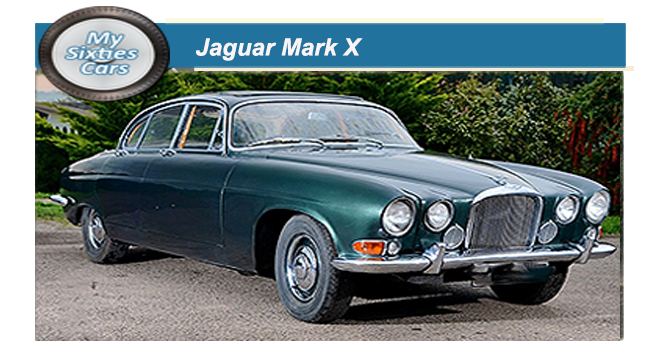 Principally designed for the United States market where big was beautiful and petrol consumption immaterial, the Mark X was the undoubted last vestige of Jaguar's Super limousine style saloons of the Fifties, still holding the title of the broadest production saloon ever produced in the UK, at 6ft 4in (1.93m) across
Principally designed for the United States market where big was beautiful and petrol consumption immaterial, the Mark X was the undoubted last vestige of Jaguar's Super limousine style saloons of the Fifties, still holding the title of the broadest production saloon ever produced in the UK, at 6ft 4in (1.93m) across
W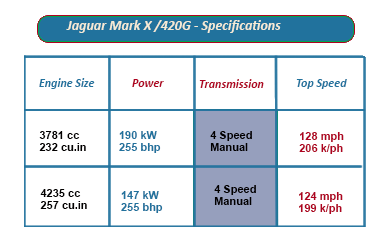 hile it shared roughly the same proportions, the Jaguar Mark X still represented a massive advance on its separate-chassis forefathers, and in the competitive markets of the prosperous early Sixties weighed in at, half the price of its nearest real competitors in the tycoon luxury class.
hile it shared roughly the same proportions, the Jaguar Mark X still represented a massive advance on its separate-chassis forefathers, and in the competitive markets of the prosperous early Sixties weighed in at, half the price of its nearest real competitors in the tycoon luxury class.
On its release, the Jaguar Mark X came equipped with a triple-carburettor 3.8-litre XK engine, the same unit that would later power the E-Type.
From 1964 onwards, Jaguar pushed the power upwards and outwards, fitting the Mark X with a 4.2-litre engine, which achieved much more acceptable results, enough to drive the 43001b (1950kg) saloon along at 120mph ( 93k/ph) even in those models fitted with automatic transmission.
S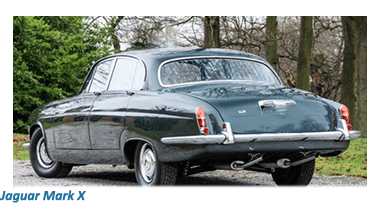 urprisingly for a car of this size, the Mark X handled reasonably well, albeit with a fair amount of body roll.
urprisingly for a car of this size, the Mark X handled reasonably well, albeit with a fair amount of body roll.
Part of the reason for this behaviour was that the Mk X was fitted with "" all-round" independent suspension taken from other models in the Jaguar range —notably the Mk II for the front and the E-type for the rear.
Refinements included Kelsey Hayes power-assisted all-round disc brakes and power steering as standard, ensuring that the Mark X gargantuan proportions would not, in any way, detract from the driving experience.
![]()
The design team at Jaguar had done their best in bringing a full-sized limousine such as the Mark X into the Sixties, mainly thanks to its double headlights set into rounded wings, the first Jaguar to have this facelift.
A practice that would go on to become the company's signature in the Sixties and onwards,
A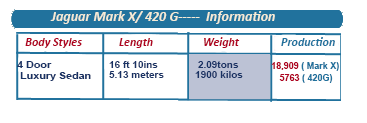 s was their practice, Jaguar fitted the Mark X with an even more sumptuous old-fashioned interior, with the emphasis very much on wood and leather.
s was their practice, Jaguar fitted the Mark X with an even more sumptuous old-fashioned interior, with the emphasis very much on wood and leather.
Solid wood was used extensively in the cabin interior — dashboard, around windows, housing various controls —and even the handy tables that folded down behind the front seats were stoutly constructed in solid timber, hand picked to complement the car’s interior.
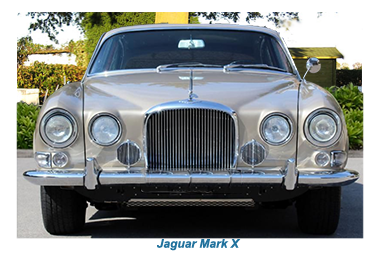 The Mark X's front seat was a vast divided bench, allowing three to sit up front in comfort.
The Mark X's front seat was a vast divided bench, allowing three to sit up front in comfort.
Production of the Mk X wound down in 1965 with the introduction of the rebadged Jaguar rebadged 420Gm effectively the Mk X Series 2.
The 420G had been handed a number of cosmetic design changes while the private hard and upmarket business sector could order a stretched version allowing the installation of a glass screen.
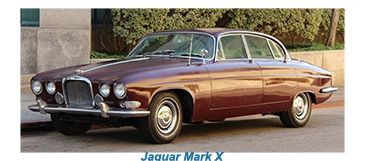 Technically the 420G continued to be fitted with the E-Type's 4235cc engine, which came with Jaguar's new all-synchromesh gearbox to go with it, although most buyers still preferred paying a little more for the option of having the Borg-Warner Model 8 automatic fitted, which replaced the old-type DG 'box.
Technically the 420G continued to be fitted with the E-Type's 4235cc engine, which came with Jaguar's new all-synchromesh gearbox to go with it, although most buyers still preferred paying a little more for the option of having the Borg-Warner Model 8 automatic fitted, which replaced the old-type DG 'box.
Other technical updated included replacing the Burman power-steering with a unit from Marles Varamatic,
Another significant change that Jaguar made with the 420G version was that the Kelsey-Hayes servo assisted braking system was replaced by a Lockheed vacuum servo.
![]()
Possibly to pay for all of these upgrades Jaguar announced that fitting air conditioning in the 420G could only be fitted as an optional extra.
While these technical updates were necessary, as far as outward appearance was concerned, the upgrade to the 420G was practically indistinguishable.
T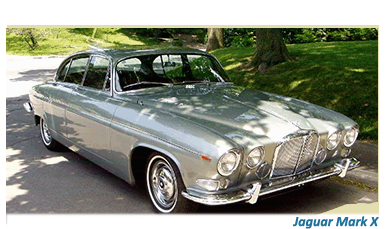 he only exterior difference was that the car now came with a full-length chrome side strips and a more substantial vertical bar down the centre of the grille.
he only exterior difference was that the car now came with a full-length chrome side strips and a more substantial vertical bar down the centre of the grille.
The interior of the 420G remained virtually unchanged, with the changes made primarily driven by owner feedback.
For example, the potentially dangerous solid timber dash rail was now padded, while the big Jags’ seats were given a minor reshape slightly to provide more lateral support.
When Jaguar launched the Mk X in the early Sixties, their design philosophy may well still have had one foot in the past but with a certain charm- broad in the beam and sumptuously curved- like a movie star of the Fifties.






